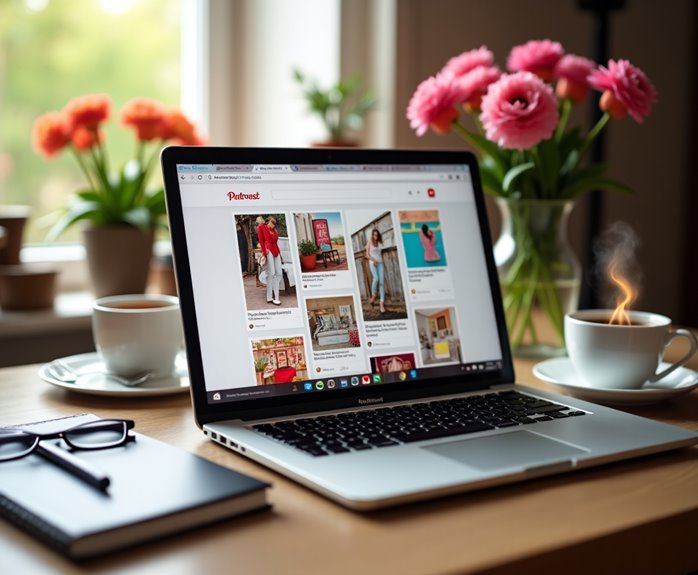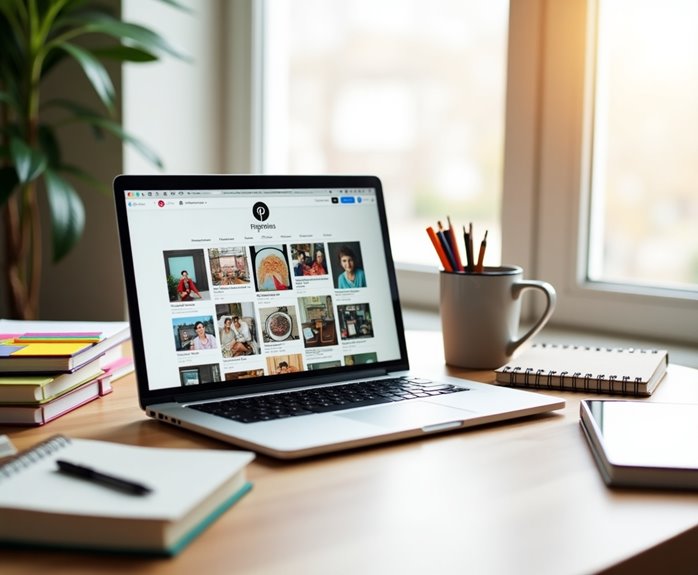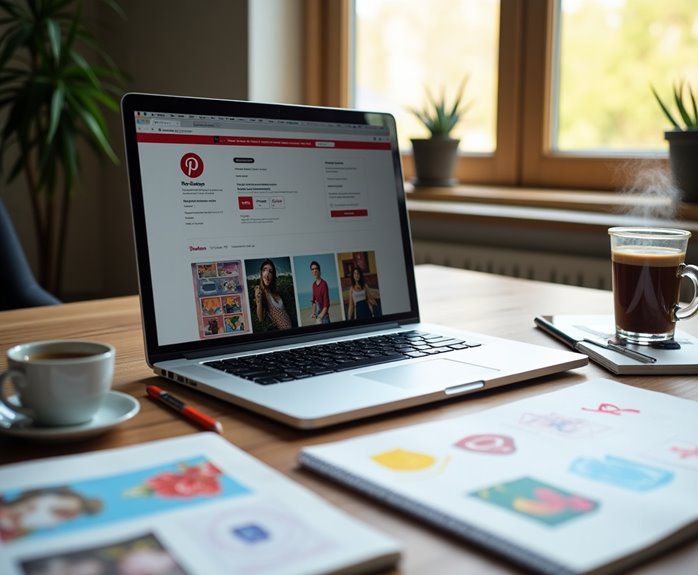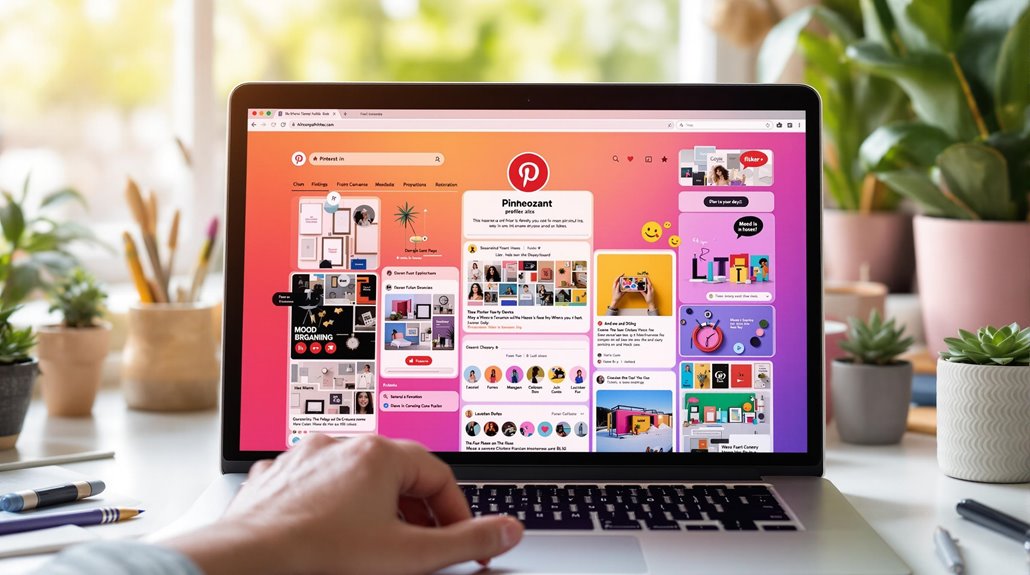To enhance your Pinterest profile for greater visibility, start by selecting a recognizable profile image and a cover image that clearly communicates your brand message. Use relevant keywords in your profile name and bio, which can greatly enhance searchability. Organize your boards with descriptive titles and logical sections, as this improves user navigation. Design high-quality pins that adhere to the ideal size of 1000 x 1500 pixels, using bright images and clear text overlays that include keywords. Regularly analyze your performance metrics to refine your strategy, as data-driven adjustments can lead to more effective engagement and discoverability. Further insights await you.
Briefly keys
- Choose a recognizable profile image and a clear cover image that aligns with your brand aesthetic for better visibility.
- Optimize your profile name and description with relevant keywords to enhance searchability and attract the right audience.
- Organize boards with descriptive titles and sections that include trending keywords for improved discoverability and user navigation.
- Create high-quality pins using bright images and compelling text overlays with relevant keywords to boost engagement and visibility.
- Regularly review analytics to adjust your strategy based on user interaction and performance metrics for continuous improvement.
Setting Up Your Profile

Setting up your Pinterest profile is crucial for making a strong first impression. Start by selecting a profile image that features either a recognizable person, someone using your product, or the product itself; this personal touch can enhance your profile aesthetics.
Your cover image should include visuals, logos, or text that effectively communicate your brand message. Consistency is key, so make sure both images align with your brand’s overall aesthetic and maintain high quality across all social media platforms.
Next, optimize your profile name with relevant keywords to improve searchability. Write a clear, concise profile description that focuses on your niche, grabbing attention while remaining specific to attract the right audience. Don’t forget to include a link to your website for added accessibility. Claiming your website establishes trust with Pinterest users and boosts content visibility.
For board titles and descriptions, utilize descriptive, keyword-rich phrases to enhance visibility. Keep board descriptions concise and reflective of the content, avoiding unnecessary embellishments.
Finally, maintain a consistent color scheme and style across all pins to guarantee branding consistency. High-resolution images and organized profiles enhance user experience, making your Pinterest presence not only visually appealing but also effective in engaging your target audience.
Conducting Effective Keyword Research
Successful keyword research is essential for maximizing your Pinterest presence. Start by using the Pinterest Search Bar; type in seed words or phrases related to your niche, and take note of the autocomplete suggestions that pop up.
After pressing enter, you’ll see additional keyword bubbles and related searches, which are great for keyword brainstorming. These suggestions can help you identify popular and relevant keywords that fit your content.
Next, conduct a competitor analysis by searching your target keyword and identifying top-performing pins. Click on these pins, copying their URLs to analyze in an incognito browser window.
Inspect the keywords used in pin descriptions and breadcrumbs, as these insights reveal effective strategies that competitors employ. Additionally, proper optimization leads to improved pin performance across the platform, enhancing your overall reach.
Consider using advanced tools like Keysearch’s Pinterest Keyword Tool, which generates related keywords and assesses their difficulty.
Pinterest Trends can also help you find trending keywords in your niche. By integrating these identified keywords into your pin descriptions and titles, you enhance your visibility, making it easier for users to discover your content.
This multi-faceted approach to keyword research will greatly improve your Pinterest strategy.
Organizing Your Boards

Clarity in organization can make a significant difference in how users interact with your Pinterest profile. Start by creating various board categories to effectively showcase your content. For instance, consider using group boards for collaborative projects, allowing multiple users to contribute ideas and resources. Secret boards are great for private planning, marked with a lock icon, ensuring only invited members can view them. Ordinary boards can contain general content that doesn’t require privacy.
Next, implement section organization within your boards. Utilize the “+ Add Section” option to categorize your pins logically, which helps visitors find specific content quickly. For example, if you have a fashion board, create sections for different styles like casual, formal, or seasonal. Moving pins into their respective sections keeps your boards organized and improves the user experience. Additionally, Pinterest analytics can provide insights into how users are interacting with your sections, helping you adjust your organization based on engagement trends.
Finally, pay attention to naming and structuring your boards. Use clear and descriptive titles, following the format “General Topic – Specific Category Within Topic.” Regularly reorganize your boards based on priority and relevance, ensuring your most important content is easily accessible while maintaining an appealing layout.
Creating High-Quality Pins
Creating high-quality pins is essential for capturing attention and driving engagement on Pinterest. Start with effective pin design by using the ideal size of 1000 x 1500 pixels, which maintains an aspect ratio of 2:3 or 1:2.1. For image selection, choose bright, well-lit, high-definition photos that clearly relate to your niche. Avoid using pixelated or blurry images, as they can diminish your pin’s appeal.
Next, guarantee your text overlays are clear and compelling. Write headlines that address a specific problem or question and include relevant keywords. Limit your font choices to 2-3 readable options, ensuring a visual hierarchy with appropriate sizes. Using warm colors can enhance engagement, so stick to a consistent color palette that represents your brand. Additionally, consistent design across your pins aids in brand recognition and enhances overall impact.
Incorporate calls-to-action to encourage viewers to visit your website, and guarantee all pin elements are aligned for a professional look.
Finally, optimize your pins for SEO by including relevant keywords in the title, description, and image filename. By following these guidelines, you’ll create high-quality pins that not only capture attention but also drive traffic and engagement effectively on Pinterest.
Developing a Pinning Strategy

When developing a pinning strategy, you’ll want to start by pinning to the most relevant boards before moving to your main board. This initial focus guarantees that your content reaches the right audience and enhances your profile’s visibility. Remember to avoid group boards that aren’t optimized for SEO, as this can negatively impact your rankings. Implementing interval pinning is vital; begin pinning to other boards the day after your initial pin to maintain a steady flow of content. To effectively enhance your pinning strategy, consider these engagement tactics:
- Create boards that include clear, descriptive titles with relevant keywords.
- Maintain consistency by posting at least one fresh image daily.
- Use Pinterest’s free scheduler to pin when your audience is most active.
- Regularly review your analytics to adjust your strategy based on user engagement.
Utilizing Pinterest Features and Tools
To make the most of your Pinterest profile, it’s essential to leverage the various features and tools available. Start by converting your account to a business profile. This gives you access to Pinterest Insights, allowing you to track pin activity and audience engagement, which helps you refine your strategy.
For branding, use the name and username fields effectively, incorporating top keywords to enhance discoverability.
Next, optimize your boards by creating them around relevant keywords, using keyword-optimized titles and descriptions. This will aid in search visibility. Custom board cover images can quickly convey the content of each board, while keyword-rich bio descriptions improve your profile’s SEO. Additionally, Pinterest targets over 1,900 keywords with paid ads, which can inspire your keyword strategy.
Utilizing tools like Tailwind Scheduling can streamline your pinning process, enabling bulk scheduling for consistent engagement. Additionally, verify your website domain to track traffic and connect your Pinterest activity with your website performance.
Don’t forget to integrate Google Analytics for deeper insights into revenue generated from Pinterest.
Lastly, confirm that your profile settings are visible to search engines, follow relevant boards, and use Guided Search for uncovering useful keywords. Engaging with these features will greatly enhance your profile’s visibility and effectiveness on Pinterest.
People are Asking
How Can I Improve My Pinterest Profile’s Visibility Organically?
To improve your Pinterest profile’s visibility organically, focus on Pinterest SEO by incorporating relevant keywords in your bio and boards. Enhance your visual branding with appealing images and consistent posting to engage your audience effectively.
What Are the Best Times to Pin for Maximum Engagement?
To maximize audience engagement, pin during the best pinning times: late afternoons and evenings, especially around 8 PM. Also, consider weekends and early evenings for higher interaction with your content.
How Do I Handle Negative Comments on My Pins?
When you handle negative comments on your pins, focus on constructive feedback. Use comment moderation techniques to acknowledge concerns, stay professional, and provide solutions. This approach fosters a positive community and encourages meaningful engagement.
Can I Link My Pinterest Account to Other Social Media Platforms?
Absolutely, you can link your Pinterest account to other social media platforms! It’s like weaving a web of Pinterest integrations, enhancing your social media cross promotion and boosting engagement across all your connected profiles.
How Often Should I Update My Profile and Boards?
You should update your profile regularly, ideally weekly, to keep it fresh. For board organization, pin new content consistently and revise descriptions every month to enhance engagement and visibility. Regular updates boost your overall performance!
Wrapping up
By optimizing your Pinterest profile, you’re not just enhancing visibility; you’re crafting a digital storefront that draws users in, much like a well-curated museum exhibit. Remember, effective keyword research, organized boards, and high-quality pins are your tools for success. Consistently applying a strategic pinning approach, along with utilizing Pinterest’s various features, can greatly increase your engagement. While you refine your profile, keep your audience’s interests in mind, and watch your visibility grow exponentially.




